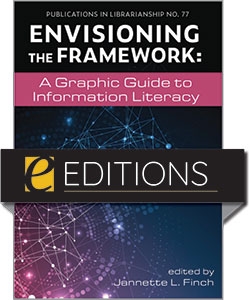
Envisioning the Framework: A Graphic Guide to Information Literacy—eEditions PDF e-book
The download link for this product can be found on the final confirmation screen after you complete your purchase, and may also be accessed from your Account Profile. For more information about ALA eEditions file types and how to view them on eReaders, desktop computers, and other devices, see this page.
Primary tabs
You don't need to be an ALA Member to purchase from the ALA Store, but you'll be asked to create an online account/profile during checkout to proceed. This Web Account is for both Members and non-Members. Note that your ALA Member discount will be applied at the final step of the checkout process.
If you are Tax-Exempt, please verify that your account is currently set up as exempt before placing your order, as our new fulfillment center will need current documentation. Learn how to verify here.
- Description
- Table of Contents
- About the author
Data visualization—making sense of the world through images that tell a story—has a history that parallels human existence. The strength of visualization lies in its ability to reveal truth out of information that may remain hidden in lines of text, large data sets, or complex ideas. The Framework for Information Literacy for Higher Education presents complex threshold concepts, developed intentionally without prescriptive lists of skills and with flexible options for implementation, which can be explored and understood through visualization.
Envisioning the Framework offers a visual opportunity for thought, discovery, and sense-making of the Framework and its concepts. Seventeen chapters packed with full-color illustrations and tables explore topics including:
- LibGuides creation through conceptual integration with the Framework
- fostering interdisciplinary transference
- the convergence of metaliteracy with the Framework
- teaching multimodalities and data visualization
- mapping a culturally responsive information literacy journal for international students
Chapters include content for credit-bearing information courses, one-shots, and teaching first-year students.
Twenty-first-century information literacy involves the metaliterate learner, reflects seismic changes in the duties and roles of teaching librarians, requires new partnerships with faculty and instructional designers, and emphasizes continuous assessment practices. Envisioning the Framework can help you use symbols and visuals for deeper understanding of the Framework, to map the Framework with teaching and learning objectives, and to tell a coherent story to students featuring the frames and the Framework.
I. Introductory
Foreword
Katy Börner
Introduction. Making the Case: The Value of Visualizing the Frames and Framework
Jannette L. Finch
Chapter 1. Data Visualization: Definitions and Brief History
Jannette L. Finch
II. Vertical
Chapter 2. Framing the Guides: Transforming LibGuides Creation through Conceptual Integration with the ACRL Framework
Brooke Duffy, Kelleen Maluski, and Gina Levitan
Chapter 3. Teaching with Infographics: Visualizing the Frames in Information Literacy Instruction for First-Year Students
Laura Wimberley and Jamie Johnson
III. Back and Forth or Side to Side
Chapter 4. Bridging the Gap: First-Year College Student Information Literacy Misunderstandings and the Framework
Jillian Collier, Allison Rand, and Lisa Janicke Hinchliffe
Chapter 5. Using an Integration Planner to Strategically Implement the ACRL Framework
Elizabeth Kamper, Juliet Gray, and Lydia Jackson
Chapter 6. Applying Visuals to Frames in Music Information Literacy Education
Sabrina Juhl and Elizabeth Brown
IV. Circular
Chapter 7. Envisioning Scholarly Conversations: Fostering Interdisciplinary Transference in General Education Information Literacy Instruction
Julie Arensdorf
Chapter 8. Delivering Faculty a Healthy Serving of the Framework
Cate Schneiderman, Christina E. Dent, Emily Belanger, and Lindsey Nichols
V. Going Over, Under, or On Top Of
Chapter 9. Visualizing the Convergence of Metaliteracy and the Information Literacy Framework
Trudi E. Jacobson, Thomas P. Mackey, and Kelsey L. O’Brien
Chapter 10. Seeing Can Become Believing: Teaching Multimodalities and Data Visualization in a Credit-Bearing Information Literacy Course
Sarah Johnson, Cynthia Kane, and Bethanie O’Dell
VI. Going Around a Boundary
Chapter 11. Overcoming Intimidation: Building a Foundation for Using the Framework
Samantha Kannegiser, Dina Meky, and Amanda Piekart
VII. Enveloping or Containing
Chapter 12. Visualizing Play and Playgrounds in Order to Understand the Framework
Shelley Harper and Betsy A. Tuma, Illustrator
Chapter 13. Discovering the Frames in One-Shot Sessions: Implications for Instruction
Jannette L. Finch, Jolanda-Pieta Van Arnhem, and Mary Jo Fairchild
VIII. Going Through a Boundary
Chapter 14. New Visions of Student Worker Training
Amy Harris, Dr. Doris Van Kampen-Breit, Jacalyn Bryan, Michelle Joy, and Kathleen Kempa
IX. Mapping
Chapter 15. Campus-wide General Education Competencies and the Visualization of Information Literacy as a Core Concept
M. Sara Lowe and Gemmicka F. Piper
Chapter 16. Mapping a Culturally Responsive Information Literacy Journey for International Students: An Interdisciplinary Approach
Yi Ding and Bessie Karras-Lazaris
Chapter 17. Mind the Gap (in Your Knowledge): Using the Framework Transit Map
Laura M. Bernhardt and Becca Neel
About the Authors
Index
Jannette L. Finch
Jannette L. Finch, MLIS, is a librarian in the College of Charleston Libraries system. Her research interests include information design and the effect of technology on student learning, online learning and teaching, effective teaching through experiential learning activities, constructivist techniques in the teaching and learning environment, visualizing data, library service models, the library role in the scholarly community, assessment, and planning. Contact her at finchj@cofc.edu.


